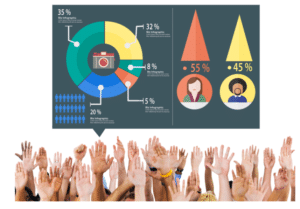In today’s digital landscape, graphic material is an integral part of successful marketing strategies. Social media platforms inundate consumers with an abundance of information and advertisements. In such a competitive environment, capturing the attention of your target audience can be challenging. This is where visual content comes into play. Visuals have the power to communicate messages effectively, evoke emotions and create a lasting touch on viewers. They provide a unique opportunity to stand out amidst the noise and interact with your audience on a deeper level.
Viral-worthy visual assets have the potential to rapidly spread across various digital platforms, generating a significant amount of shares, likes, comments and overall presence. These posts can captivate and resonate with a wide audience, leading to increased brand visibility, awareness and potentially even conversions.
Why Effective Visual Resources Matter
The primary goals of creating viral-worthy graphic materials are to maximize reach and enhance audience involvement. The broader your reach, the more potential customers you can attract. Moreover, the more connected your audience is, the more likely it is that they will develop a deeper connection with your brand and take desired actions, such as making a purchase or signing up for a newsletter.
To achieve these goals, we need to focus on creating visual elements that are not only visually appealing but also have the potential to go viral. This blog will delve into strategies and best practices for creating viral-worthy graphic content, including understanding the psychology behind viral content, conducting thorough research and planning and crafting compelling visuals that leave a lasting impression.
Conducting In-Depth Audience Research And Segmentation
To create viral image-based content, you need to have a deep understanding of your organization’s target audience. Conducting in-depth audience research and segmentation is a crucial step in this process. By identifying your audience’s demographics, interests, preferences and behaviors, you can tailor your visual elements to resonate with them on a personal level. Here are some key steps to consider:
- Define Your Target Audience. Start by clearly defining your target audience based on factors such as age, gender, location, profession and interests. This will serve as a foundation for your research and content creation efforts.
- Gather Demographic Data. Use various research methods, including surveys, interviews and marketing analytics tools, to collect demographic information about your audience. This data will help you understand their characteristics, such as age, income level, education and purchasing habits.
- Identify Audience Needs And Pain Points. Dig deeper to uncover your audience’s needs, challenges and aspirations. Understanding their pain points will allow you to create visual artwork that addresses their concerns and provides valuable solutions.
- Conduct Market Research. Analyze industry reports, trends and competitor analysis to gain insights into the market landscape. Identify gaps or opportunities where your visual creations can stand out and offer a unique value proposition.
Analyzing Competitor Visual Strategies And Differentiators
Analyzing your competitors’ visual strategies can provide valuable insights and help you differentiate your own content. Here’s how you can effectively analyze competitor visual strategies:
- Identify Competitors. Make a list of your key competitors in the market. These are the brands or businesses that target a similar audience or offer similar products or services.
- Visual Creation Assessment. Evaluate your competitors’ visual elements across various channels, including their website, social media profiles, blog posts and advertising campaigns. Look for patterns, themes and styles they consistently use.
- Identify Differentiators. Identify what sets your competitors apart in terms of visual imagery. Use specific design elements, colors or storytelling techniques. Determine their strengths and weaknesses to find opportunities for improvement and innovation.
- Benchmarking. Compare your own multimedia with your competitors. Identify areas where you can outperform them or bring unique perspectives to the table. This analysis will help you position your visual artwork in a way that stands out and brings value to your audience.
Utilizing Data Analytics And Social Listening For Insights
Data analytics and social listening tools provide invaluable insights into your audience’s behaviors, preferences and connection patterns. By leveraging these tools, we can optimize their multimedia strategy for maximum outcomes. Here’s how:
- Track Engagement Metrics. Use analytics tools to track and measure the performance of your visual creation. Monitor metrics such as views, shares, likes, comments and click-through rates. Analyze which types of visual elements generate the highest interaction and adjust your strategy accordingly.
- Social Listening. Social listening involves monitoring online conversations and discussions related to your brand, industry or relevant topics. It helps you understand what your audience is saying, what they are interested in and what trends or challenges they are discussing. Use social listening tools to gather insights and incorporate them into your visual artwork planning.
- A/B Testing. Conduct A/B testing to compare the effectiveness of different visual elements or strategies. Test variations in design, messaging or calls to action to determine what resonates best with your audience. This iterative approach allows you to refine and optimize your visual compositions for better performance.
By conducting in-depth audience research, analyzing competitor strategies and utilizing data analytics and social listening, we can create viral-worthy visual content that truly connects with your business’s target audience.
Crafting Compelling Visuals For Maximum Result
Capturing and retaining your audience’s attention is crucial in today’s fast-paced digital landscape. To create viral visual material, we must master the art of crafting compelling visuals that leave a lasting impression. Here are key elements to consider when creating visuals for maximum impact:
Advanced Design Principles For Visually Stunning Content
- Simplicity. Keep your content clean and uncluttered. Focus on a central message or idea and eliminate unnecessary elements that may distract or confuse your audience.
- Balance. Achieve balance by distributing elements evenly throughout your design. Consider the placement of text, images and other visual components to create a harmonious composition.
- Visual Hierarchy. Use varying sizes, colors and positions to guide the viewer’s attention. Highlight key elements or messages to ensure they are immediately noticed and understood.
- Consistency. Maintain a consistent style across your content to establish brand recognition. Consistency in colors, fonts and overall design aesthetic enhances brand identity and strengthens your message.
Strategic Use Of Color, Composition And Typography
- Color Psychology. Different colors evoke specific emotions and associations. Understand the psychology behind colors and select a palette that aligns with your brand personality and desired audience response.
- Composition Techniques. Apply composition principles such as the rule of thirds, leading lines and framing to create appealing and balanced designs. Experiment with different compositions to add depth and visual interest.
- Typography. Choose fonts that complement your brand and content. Consider legibility, hierarchy and font pairings to enhance the overall design. Typography should be easy to read and reinforce the desired message.
Incorporating Interactive Elements And Dynamic Visuals
- Interactive Elements. Connect with your audience by incorporating interactive elements such as clickable buttons, sliders or quizzes. Interactive visuals encourage active participation and enhance the overall user experience.
- Animated And Video Content. Utilize animations or video content to convey your message more dynamically. Movement attracts attention and increases responses, making your visuals more memorable and shareable.
Infographics And Data Visualization. Present complex information in a visually appealing and digestible format. Utilize infographics and data visualizations to simplify data and tell compelling stories through visuals.
Techniques For Creating Shareable And Memorable Visuals
- Embrace Visual Storytelling. Create visuals that tell a story and evoke emotions. A narrative-driven approach makes your content relatable and memorable, increasing the likelihood of it being shared.
- Use Humor And Wit. Inject humor and wit into your visual media when appropriate. Humorous visuals have a higher chance of being shared and can help your brand stand out.
- Incorporate User-Generated Content. Encourage your audience to participate by sharing user-generated content related to your brand. It fosters a sense of community and creates a connection with your audience.
- Optimize for Mobile. Ensure your visuals are mobile-friendly and optimized for different screen sizes. With the increasing use of mobile devices, it is essential to deliver a seamless experience across all devices.
Crafting compelling visuals requires a deep understanding of design principles, strategic use of color and typography and the incorporation of interactive or dynamic elements. By applying these techniques, you can create shareable, memorable and valuable content that resonates with your business’s target audience.
Maximizing Reach And Interaction Through Content Distribution
Once you have crafted compelling content, the next step is to ensure that it reaches a wide audience and drives maximum interaction. In this section, we will explore effective strategies for content distribution that can help you maximize reach and activity.
Leveraging Content Sharing And Partnerships
Content syndication involves distributing your content through various third-party platforms to expand its reach. By partnering with relevant websites, blogs or online publications, you can tap into their existing audiences and gain exposure for your visual imagery. Here’s how you can leverage content syndication and partnerships:
- Identify Relevant Platforms. Research and identify reputable platforms that align with your target audience and industry. Look for websites, blogs or online publications that accept syndicated content.
- Build Relationships. Reach out to these platforms and establish relationships with their editors or content managers. Offer them your graphic visuals for syndication, providing them with high-quality visuals and compelling descriptions.
- Create Exclusive Content. Consider creating exclusive visuals specifically for syndication partners. This can incentivize them to feature your content and provide their audience with unique and valuable visuals.
- Collaborate With Influencers. Partner with influential individuals or industry experts who have a significant following. Collaborate on visual design creation and have them share it with their audience, amplifying your reach and interaction.
Utilizing Email Marketing And Newsletter Campaigns
Email marketing remains a powerful tool for distributing visual materials and engaging with your audience directly. By leveraging email campaigns and newsletters, you can deliver your visuals directly to subscribers’ inboxes. Here’s how to effectively utilize email marketing:
- Build An Active Subscriber List. Focus on growing your email subscriber list by offering valuable incentives such as exclusive content or discounts. Use opt-in forms on your website and social media channels to capture email addresses.
- Segment Your Audience. Divide your subscribers into different segments based on demographics, preferences or interaction levels. This allows you to tailor your email campaigns and deliver relevant visual designs to specific audience segments.
- Visual-First Emails. Design visually appealing emails that showcase your content prominently. Use eye-catching images, personalized subject lines and compelling call-to-action buttons to drive engagement and click-through rates.
- Nurture And Automate. Develop a nurturing email sequence to deliver a series of visual representations over time. Automate your email campaigns to ensure consistent and timely delivery of visual presentations to your subscribers.
Cross-Platform Promotion And Integration
To maximize reach and response, it is essential to promote your visual media across multiple platforms and integrate it seamlessly into your marketing channels. Consider the following strategies for cross-platform promotion and integration:
- Social Media Integration. Share your visual resources across various social media platforms, including Facebook, Instagram, Twitter, LinkedIn and YouTube. Optimize your visuals for each platform’s specifications and leverage features such as hashtags, reels and stories.
- Website Integration. Feature your visual illustrations prominently on your website. Create dedicated landing pages or galleries to showcase your visuals and encourage visitors to explore and interact with them.
- Paid Advertising. Utilize paid advertising platforms, such as Google Ads or social media ads, to amplify the reach of your content. Develop targeted ad campaigns that display your visuals to relevant audiences based on demographics, interests or behaviors.
- Cross-Promotion With Partners. Collaborate with complementary brands or businesses to cross-promote each other’s content. This can include guest posting, co-creating visuals or mentioning each other in newsletters or social media posts.
Measuring And Analyzing The Value Of Viral Visual Illustrations
Once you have created and distributed your viral visual imagery, it is essential to measure and analyze its importance to understand its effectiveness and optimize future campaigns. In this section, we will explore key strategies and tools for measuring and analyzing the contribution of viral visual design.
Utilizing Advanced Analytics Tools And Tracking Metrics
To effectively measure the impression of your viral visual media content, it is important to leverage advanced analytics tools and tracking metrics. Here are some tools and metrics that can provide valuable insights:
- Google Analytics. Use Google Analytics to track website traffic, user behavior and conversions driven by your visual media. Set up specific goals and event tracking to measure the impact of your visuals on user participation and conversions.
- Social Media Analytics. Each social media platform offers its own analytics tools that provide valuable insights into the performance of your visual communication. Track metrics such as reach, online presence, follower growth and referral traffic to understand the weight of your visuals on social media.
- Heatmaps And Click Tracking. Heatmap tools like Hotjar or Crazy Egg can help you analyze how users interact with your visual materials on your website. These tools provide visual representations of where users click, scroll or spend the most time, helping you identify areas of interest or potential improvements.
- URL Tracking Parameters. Use URL tracking parameters, such as UTM codes, to track the performance of your multimedia across different marketing channels. This allows you to attribute traffic and conversions to specific campaigns or visuals.
Future Trends And Innovations In Viral Visual Elements
It is necessary to stay ahead of the curve and anticipate future trends and innovations in visual storytelling. Let’s now explore some emerging technologies, the potential of artificial intelligence (AI) in content creation and the importance of predicting and adapting to changing consumer behaviors.
Emerging Technologies And Their Impact On Graphic Material
Virtual Reality (VR) and Augmented Reality (AR) technologies have the potential to revolutionize the way we consume and interact with graphic elements. These immersive technologies create captivating experiences that interact and entertain audiences. For example, brands can use AR to allow customers to visualize products in their own environment before making a purchase, or create virtual experiences that transport users to different locations or scenarios.
360-Degree Videos provide a fully immersive viewing experience, allowing users to explore and interact with the content from different angles. This technology is particularly effective in industries such as travel and real estate, where customers can virtually experience destinations or tour properties.
Live Streaming has gained significant popularity in recent years, with platforms like Facebook Live, Instagram Live and YouTube Live enabling real-time connection with audiences. Brands can leverage live streaming to showcase behind-the-scenes content, host Q&A sessions or broadcast live events, creating a sense of exclusivity and fostering a deeper connection with their audiences.
Exploring The Potential Of Artificial Intelligence (AI) In Content Creation
Artificial intelligence (AI) is revolutionizing various aspects of marketing, including content creation. Here’s how AI can enhance viral graphic material creation:
- Automated Image And Video Editing. AI-powered tools can automate image and video editing processes, making it faster and more efficient to create visually appealing content. These tools can enhance images, apply filters and even generate personalized videos based on user preferences.
- Personalized Visual Materials. AI algorithms can analyze user data and preferences to create personalized visual resources tailored to each individual. This level of personalization enhances activity and helps brands deliver more relevant and significant content.
Voice-Activated Visual Experiences. With the rise of voice assistants like Amazon Alexa and Google Assistant, incorporating voice-activated visual experiences into viral content is becoming more prevalent. Brands can create interactive visuals that respond to voice commands, providing a unique and engaging user experience.
Predicting And Adapting To Changing Consumer Behaviors

Propel your brand to viral stardom with meticulously crafted content, sparking an unstoppable wildfire of engagement.
Consumer behaviors and preferences are constantly evolving, and it’s crucial for marketing agencies and directors to stay attuned to these changes. Here are some strategies to predict and adapt to changing consumer behaviors:
- Utilize social listening tools and data analytics to monitor conversations, trends, and sentiment around your brand and industry. This helps you identify emerging topics, preferences and consumer behaviors that can inform your visual composition strategies.
- Maintain an agile and flexible approach to your multimedia strategy. Stay open to experimenting with new formats, platforms and trends to adapt to changing consumer behaviors. Continuously monitor and analyze the performance of your visuals to identify opportunities for improvement and optimization.
Are You Ready To Create Viral Visual Assets And Maximize Reach?
Creating viral-worthy visual aesthetics requires a strategic and multi-faceted approach. By understanding the importance of visual assets in modern marketing and defining what makes content viral-worthy, we can set the foundation for success.
It’s important to apply these insights and strategies to your own graphic material campaigns. Take the time to conduct thorough research, explore innovative design approaches and leverage data analytics to inform your decisions. Stay agile and adaptable in the ever-evolving marketing landscape and be open to embracing emerging technologies that can elevate your visual compositions to new heights.
If you’re seeking assistance, Three Girls Media is here to support you. Contact us today for a free 30-minute consultation and discover how we can enhance your business. Our team of skilled marketers is ready to elevate your visual communication and make your business greater success.



